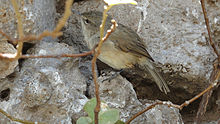Nihoa millerbird
| Nihoa millerbird | |
|---|---|
 |
|
| On the island of Nihoa, Northwestern Hawaiian Islands | |
| Scientific classification | |
| Kingdom: | Animalia |
| Phylum: | Chordata |
| Class: | Aves |
| Order: | Passeriformes |
| Family: | Acrocephalidae |
| Genus: | Acrocephalus |
| Species: | A. familiaris |
| Subspecies: | A. f. kingi |
| Trinomial name | |
|
Acrocephalus familiaris kingi (Wetmore, 1923) |
|
The Nihoa millerbird (Acrocephalus familiaris kingi) is a subspecies of the millerbird. It gets its name from its preferred food, the Miller moth. The 5-inch (13 cm) long millerbird has dark, sepia-colored feathers, white belly, and dark beak. Its natural geographic range is limited to the tiny island of Nihoa in the Northwestern Hawaiian Islands, and it is hoped that birds translocated to Laysan will help to ensure the survival of the species. The Nihoa millerbird is one of the two endemic birds remaining on Nihoa, the other being the Nihoa finch.
Only 200– 900 Nihoa millerbirds persist on the island, making the species seriously endangered. It is always at risk of extinction from environmental changes (droughts, fires, insect population irruptions), because flight away from the island would likely prove fatal. The Laysan millerbird, now extinct, was closely related.[1]
The trinomial commemorates Samuel Wilder King, captain of the Tanager Expedition and later Governor of Hawaii.
24 Nihoa millerbirds were translocated by ship about 650 miles (1,050 km) from Nihoa to Laysan in September 2011 after years of planning with the aim of establishing a second population of the species on Laysan. Mark MacDonald, a graduate student from the University of New Brunswick in Canada, lead a team that was working with the Service to collect information needed for translocations. From July through September 2007, MacDonald and his team captured and banded Nihoa millerbirds, collected body measurements, assessed body fat and breeding condition, identified individual territories and analyzed vocalizations, conducted feeding experiments, collected fecal samples, observed behavior to determine diet composition, noted the presence and abundance of non-native grasshoppers, and sampled the insect community on both Nihoa and Laysan to assess the millerbird’s potential prey base. MacDonald’s study estimated the Nihoa millerbird’s population at approximately 800 individuals – a relatively high number in 40 years of low and fluctuating numbers. He believes that this could be attributed not only to high numbers of birds present during the survey period but also a larger survey area, the use of more experienced observers, or (most likely) the greater visibility of the birds during the late summer, when vegetation cover is most limited.
...
Wikipedia

